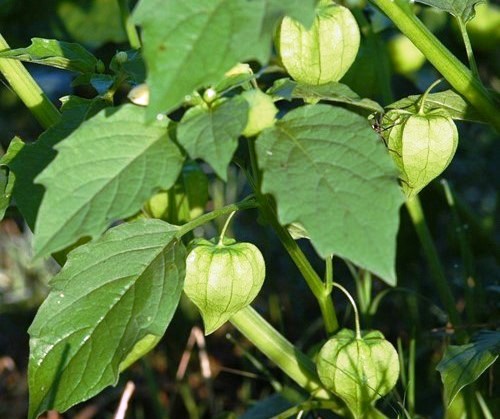Physalis angulata

|
|
Physalis angulata Common Names: Angular winter cherry, Balloon cherry,
Cutleaf groundcherry, Gooseberry, Wild cape gooseberry Scientific
Classification Kingdom: Plantae Clade: Angiosperms Clade: Eudicots Clade: Asterids Order: Solanales Family: Solanaceae Genus: Physalis Species: P. angulata Binomial Name: Physalis angulata L. Synonyms: Boberella angulata (L.) E.H.L.Krause, Physalis esquirolii H.Lév. & Vaniot, Physalis minima auct. non L. (misapplied) Morphological Description Physalis angulata is an annual herbaceous plant, typically growing to 0.3–1 m
in height, with a sprawling or erect habit. It is characterized by: · Stem: Angular, hollow, green to purplish, often glabrous or with
sparse short hairs · Leaves: Alternate, ovate to lanceolate (3–10 cm long, 2–6 cm wide),
with irregularly toothed or lobed margins, and a soft, slightly velvety texture · Flowers: Solitary, small (5–10 mm in diameter), pale yellow to cream,
bell-shaped, with 5 petals and a slightly nodding posture · Fruit: Globose berry (1–2 cm in diameter), yellow-orange when ripe,
enclosed in an inflated, papery calyx (2–4 cm long) that turns brown and
brittle at maturity Distribution and Habitat Physalis angulata is believed to be native to tropical Americas, though its
exact origin remains debated, with possible secondary origins in Australia or
Southeast Asia. It is now pantropically distributed as a weed, naturalized in: · Africa: Nigeria, Ghana, Cameroon, widespread in disturbed areas · Americas: Southern USA to Paraguay, common in fields and roadsides · Asia: India, Indonesia, Malaysia, thriving in tropical climates · Oceania: Northern Australia, Pacific Islands, often in cultivated
lands It prefers well-drained
soils (pH 5.5–7.5), full sun to partial shade, and annual rainfall of 800–2,000
mm, frequently colonizing disturbed habitats like roadsides, gardens, and
agricultural fields (Rivera et al., 2015). Ethnopharmacology Physalis angulata, commonly known as balloon cherry or cutleaf
ground cherry, is a plant recognized for its diverse medicinal properties.
Traditionally, various parts of the plant have been utilized to address
ailments such as malaria, hepatitis, asthma, and rheumatism. Phytochemical
analyses have identified bioactive compounds in Physalis angulata, including physalins and withanolides, which
contribute to its therapeutic effects.While these findings underscore the
medicinal potential of Physalis angulata, further research is necessary to
fully elucidate its efficacy and safety profiles. Consultation with healthcare
professionals is recommended before incorporating this plant into therapeutic
practices. · Wound Healing: In Nigeria, leaf pastes treat cuts and sores. Aqueous
extracts enhance wound contraction by 80–90% and collagen synthesis in rat
models, linked to geraniin (Boakye et al., 2018). · Anti-inflammatory: In Brazil, whole-plant infusions reduce
rheumatism and sore throat. Ethanolic extracts inhibit PGE₂ and TNF-α by 40–60%
in LPS-stimulated macrophages, due to physalins B and F (Rivera et al., 2018). · Anticancer: In Peru, fruit decoctions are used for tumors. Physalin F
shows cytotoxicity against HeLa cells (IC₅₀ 5–10 μg/mL) and induces apoptosis
in MCF-7 breast cancer cells (Chiang, et al., 1992). And physalin B and
physalin D, isolated from the aerial parts of Physalis angulata, have
demonstrated considerable cytotoxicity in vitro against several cancer cell
lines, with IC₅₀ values ranging from 0.28 to 15.18 μg/mL. In vivo studies using
mice bearing sarcoma 180 tumor cells confirmed their antitumor activity, which
was associated with the inhibition of tumor proliferation, as evidenced by
reduced Ki67 staining in treated animals (Magalhães, et al., 2006). · Antimicrobial: In Indonesia, leaf extracts combat infections. Ethanolic
extracts from the plant's calyces have shown antibacterial activity against
multiple strains, including S. aureus, K. pneumoniae, and P. aeruginosa. The
dichloromethane fraction of these extracts maintained potent antibacterial
effects with MIC values ≤128 μg/mL against all tested strains, without
cytotoxicity to normal human dermal fibroblasts (Rivera et al., 2015). · Antiparasitic: In Colombia, plant infusions treat malaria. Extracts
reduce Leishmania amazonensis promastigotes by 50% at 20 μg/mL, supporting antileishmanial
use (Novitasari et al., 2024). · Antidiabetic: In India, aerial parts manage blood sugar. Withangulatin A
lowers glucose by 25% in STZ-induced diabetic rats at 100 mg/kg (Sarin et al.,
2014). ⚠ Toxicity Profile: Ripe fruits are edible and safe, but unripe
fruits, leaves, stems, and flowers contain solanine and solanidine alkaloids,
causing nausea, vomiting, and neurological symptoms at high doses (LD₅₀ >
1,000 mg/kg in rats). While acute toxicity appears minimal, prolonged use of P.
amarus may pose risks. A study evaluating the chronic administration of the
plant in rats observed histological changes in kidney tissues, including
distortion and disruption of renal architecture. These findings suggest
potential nephrotoxic effects with long-term consumption. (Adjene et al.,
2010). Phytochemistry The plant’s bioactivity
stems from a diverse chemical profile: · Physalins: Seco-steroidal lactones (e.g., physalin B, D, F, G; 0.1–0.5%
dry weight), driving anti-inflammatory, anticancer, and antimicrobial effects · Withanolides: Steroidal lactones (e.g., withangulatin A, physagulin A–G;
0.05–0.3%), linked to antidiabetic and cytotoxic properties · Flavonoids: Quercetin, kaempferol (0.1–0.5%), contributing to
antioxidant activity · Alkaloids: Phygrine (trace amounts), with potential sedative effects These constituents highlight
its therapeutic versatility (Patel et al., 2011). Additional Uses · Culinary: Ripe fruits consumed fresh or in salads in tropical regions · Cultural: Used in Brazilian rituals for purification due to its
symbolic calyx · Agricultural: Hosts pests and diseases affecting Solanaceae crops References
External Links More Pictures
|
|
| Compounds of Physalis angulata | |
| References |